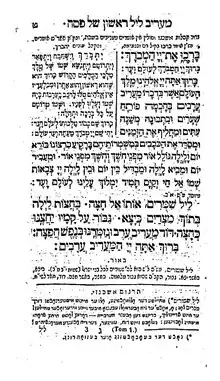
Lel Shimurim Oto El Hatzah (Hebrew: ליל שמורים אותו אל חצה, literally 'The Night of Protection which God Split in Half') is a Maariv piyyut for the Maariv service on the first night of Passover (the seder night) of unknown authorship, which originated in the classical period of piyyut (6th-8th century). This piyyut was accepted in all the communities of Ashkenaz and Poland,[1] France,[2] Italy,[3] Romania,[4] Algeria,[5] and also in the rites of Provence and Catalonia.[6]
Alternative Zulat
In the Ashkenazic rite (as well as the Provençal and Catalonian rites), the original Zulat (the piyyut before Mi Khamokhah), which continues the acrostic from the previous section, is missing, and instead there is an alternate Zulat which interrupts the alphabetic order. The alternate piyyut is longer, and it has its own independent alphabetic acrostic. Its theme is a comparison between the Exodus from Egypt and the future redemption, and it has alternating refrains: "In the days of the Passover festival" and "As in the days of the Passover festival." The original text is preserved in genizah fragments, and in the Italian and Romaniote rites.[7]
Bikkur

In the Western Ashkenaz rite,[8] before the conclusion of Hashkiveinu, there is an additional bikkur by Rabbi Meir sheliach tzibbur Ezkerah Shenot 'Olamim ("I will remember the years of the past"), discussing the Passover sacrifice. In the other rites, this bikkur does not appear.
English translations
The piyyut has been translated several times, including Jenny Marmorstein's translation of the Rödelheim machzor.[9] It also appears with an English translation in the Artscroll Passover machzor.
Mentions
The piyyut is quoted in several early rabbinic works. For example, Sefer Ha-manhig, Laws of Passover[10] says that 'There are those who say that Rav would not eat on the day of before Passover because Rav was a firstborn. And this is because God 'killed the firstborn of Ham (Egypt) and upon his firstborn son had mercy'. The phrase 'killed the firstborn of Ham (Egypt) and upon his firstborn son had mercy' is a direct quote from the alternate zulat recited in Ashkenazic communities.
Musical Performances
- Jacob Koussevitzky, the final section of the piyyut.
- Trio Lorend, the first section of the piyyut.
- The alternative (Ashkenazic) zulat was set to music in the 19th century by Samuel Naumbourg (Naumbourg claims it is based on a traditional melody, but his setting is very ornate and it is hard to believe it preserves much of the traditional melody), but it apparently has never been recorded, and it is found in S. Naoumbourg, Chants liturgiques des grandes fêtes, 2ème Partie (1847), page 126.
External links
- Hebrew text of the piyyut, incorporated into the evening service according to Nusach Ashkenaz, on Wikisource.
- Yonah Fraenkel, Machzor for Passover, Jerusalem 1993, page 9 and on.
References
- ↑ It appears in all manuscripts and printed editions of these rites (except for some very recent machzorim that have removed piyyutim entirely).
- ↑ The piyyut does not appear in the printed Machzor Vitry, where a different two Lel Shimurim appear instead for the first two night. However, in the Reggio manuscript of Machzor Vitry, this piyyut appears for the first night, followed by the other two piyyutim. See Yonah Fraenkel, Machzor for Passover, Jerusalem 1993, page 22 in the introduction.
- ↑ It appear in the 1486 and 1540 editions of this Machzor. In later editions, it does not appear.
- ↑ Machzor Romania, Venice 1523, page 109b. Today, it is recited in Kehila Kedosha Janina, but before the blessings of Shema and not inside the blessings.
- ↑ Yonah Fraenkel, Machzor for Passover, Jerusalem 1993, page 23 in the introduction.
- ↑ Idan Peretz, Siddur Catalonia, Jerusalem 2019, page 392.
- ↑ In the 1523 Romaniote machzor, the original zulat does not appear, but rather the Ashkenazic piyyut with an instruction "some add". But in the 1665 Romaniote machzor, the original text does appear (and the Ashkenazic text does not appear at all). The original text appears in an academic edition based on manuscripts in Yonah Fraenkel, Machzor for Passover, Jerusalem 1993, page 13.
- ↑ It also appears in some manuscripts and printed versions of the Eastern Ashkenazic rite, but in practice it has not been recited in this rite since Rabbi Isaac Tyrnau wrote not to recite it.
- ↑ Basle : Victor Goldschmidt Publishers, 1967.
- ↑ Page 465.